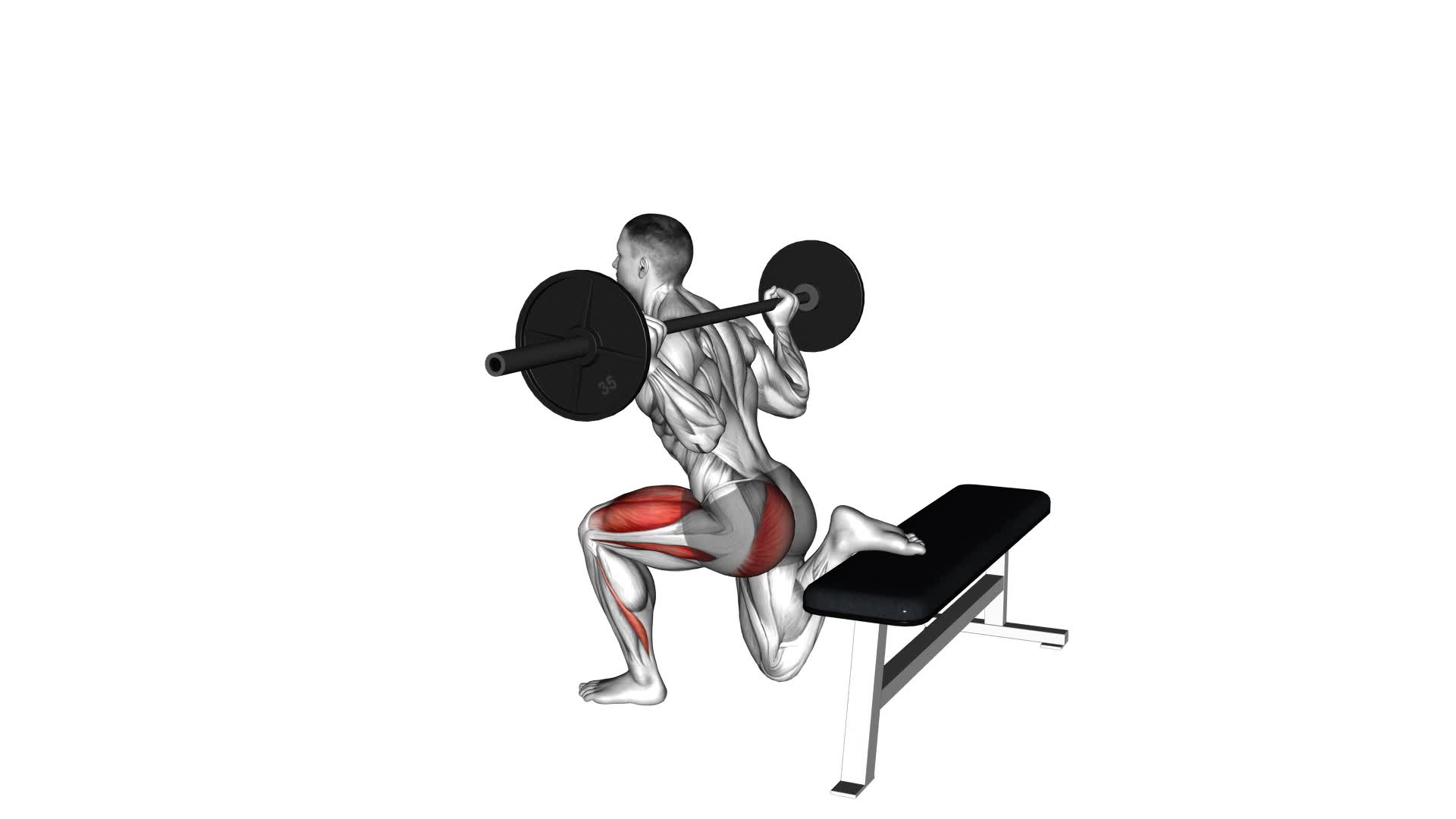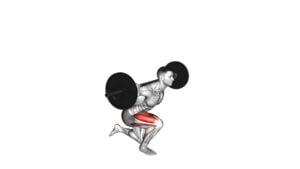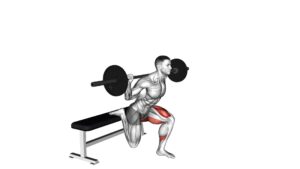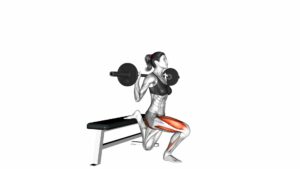Barbell One Leg Squat – Video Exercise Guide & Tips

Looking to strengthen your lower body and challenge your balance? The Barbell One Leg Squat is the perfect exercise for you.
Watch This Exercise Video
In this video exercise guide, we'll show you how to perform this challenging movement with proper form and technique. Whether you're a beginner or an advanced fitness enthusiast, we've got modifications and progressions to suit all levels.
Don't miss out on the benefits of this effective exercise. Let's get started!
Key Takeaways
- Barbell one leg squats target multiple muscle groups, including quads, hamstrings, and glutes.
- Proper form and technique are crucial to maintain knee alignment, weight distribution, and core engagement.
- Modifications and progressions can be made for all fitness levels, from beginners to advanced.
- It is important to avoid common mistakes such as incorrect knee alignment, improper foot positioning, and lack of core engagement to prevent injuries.
Benefits of the Barbell One Leg Squat
You can maximize your strength and stability with the benefits of the Barbell One Leg Squat. This exercise isn't only challenging but also highly effective in targeting multiple muscle groups.
One of the biggest advantages of the Barbell One Leg Squat is that it helps develop stronger leg muscles, particularly the quads, hamstrings, and glutes. By focusing on one leg at a time, you engage these muscles more intensely, leading to increased strength and definition.
Additionally, the Barbell One Leg Squat is a great alternative to traditional squats as it requires more balance and stability. This exercise forces you to activate your core and stabilizer muscles to maintain proper form, enhancing your overall balance and coordination. It also helps improve your ankle and hip stability, which can be beneficial for athletes participating in sports that require quick changes in direction or explosive movements.
Incorporating Barbell One Leg Squats into your workout routine can increase your lower body strength, stability, and overall athletic performance.
Transitioning now to the subsequent section about the equipment needed for this exercise, it's important to have a barbell, weights, and a squat rack to properly perform the Barbell One Leg Squat.
Equipment Needed for the Exercise
To properly perform the Barbell One Leg Squat, you'll need a barbell, weights, and a squat rack. These items are essential for ensuring a safe and effective workout.
Firstly, you'll need a barbell. This is a long metal bar that you can load with weights. It should be sturdy and able to support the weight you'll be lifting. Make sure to choose a barbell that's appropriate for your fitness level and goals.
Next, you'll need weights. These can be in the form of plates that you can slide onto the barbell. The amount of weight you choose will depend on your strength and fitness level. It's important to start with a weight that challenges you but is still manageable. Gradually increase the weight as you become stronger and more comfortable with the exercise.
Lastly, you'll need a squat rack. This is a piece of equipment that allows you to safely perform the exercise by providing stability and support. The squat rack should be adjustable so that you can set it at the appropriate height for your height and range of motion.
Proper Form and Technique for the Barbell One Leg Squat
To perform the barbell one leg squat with proper form and technique, there are a few key points to keep in mind.
First, focus on maintaining proper knee alignment and stability throughout the movement to prevent any unnecessary strain or injury.
Second, ensure proper weight distribution and balance to effectively engage the targeted muscles and maintain control.
Knee Alignment and Stability
To ensure proper knee alignment and stability during the barbell one leg squat, it's important to focus on maintaining control and balance throughout the movement. This exercise requires good knee stability and proper knee tracking to prevent any potential injuries.
To achieve this, keep your knee in line with your toes and avoid any inward or outward movement. Engaging your core muscles and keeping your body weight centered will help maintain stability in your knee joint.
Additionally, it's crucial to use a weight that's appropriate for your strength level to avoid putting excessive stress on your knees. By practicing proper form and technique, you can improve knee alignment and stability during the barbell one leg squat.
Weight Distribution and Balance
Maintain proper weight distribution and balance during the barbell one leg squat by focusing on controlling your movements and keeping your body centered. This is crucial to ensure you perform the exercise safely and effectively.
Here are some tips to help you achieve optimal weight distribution and body control:
- Keep your core engaged throughout the movement to stabilize your body.
- Maintain an even distribution of weight between your supporting leg and the foot of your working leg.
- Avoid leaning too far forward or backward, as this can throw off your balance.
- Concentrate on keeping your hips level and aligned with your supporting leg.
- Focus on a slow and controlled descent, maintaining control of the movement at all times.
Modifications and Progressions for All Fitness Levels
As you progress in your fitness journey, you can modify and progress the barbell one leg squat to suit your current fitness level.
For beginners, it's important to start with modifications that help build strength and stability. One modification is to perform the exercise with a support, such as a chair or wall, to assist with balance. This can help beginners focus on proper form and technique without worrying about falling or losing balance.
Another modification is to decrease the range of motion by not going as low in the squat. This reduces the demand on the muscles and joints, making it more manageable for beginners.
For advanced progressions, there are several options to challenge yourself and continue improving.
One progression is to increase the weight by using a heavier barbell or adding weights to the barbell. This increases the resistance and forces the muscles to work harder.
Another progression is to perform the exercise on an unstable surface, such as a Bosu ball or balance board. This adds an element of instability, requiring more core engagement and balance.
Additionally, you can try performing the exercise with one leg elevated, either by using a step or a bench. This increases the demand on the working leg and challenges your stability even more.
Remember to listen to your body and progress at a pace that's comfortable for you. It's important to challenge yourself, but also to prioritize safety and proper form.
Common Mistakes to Avoid While Performing the Exercise
To perform the barbell one leg squat correctly, it's crucial to pay attention to your knee alignment during the squat. Make sure your knees stay in line with your toes and don't collapse inward.
Additionally, proper foot positioning is essential for stability and balance, so ensure your feet are shoulder-width apart.
Lastly, engage your core muscles throughout the exercise to maintain proper form and prevent injury.
Knee Alignment During Squat
Ensure proper knee alignment during the barbell one leg squat by focusing on your form and engaging your core. Correct knee alignment is crucial for optimal knee biomechanics and injury prevention. Here are some key points to keep in mind:
- Keep your knee in line with your toes. Avoid allowing your knee to collapse inward or flare outward.
- Maintain a neutral spine throughout the movement to reduce stress on your knees.
- Engage your glutes and quadriceps to stabilize your knee joint.
- Control the descent and ascent of the squat to avoid excessive pressure on your knees.
- Use a mirror or have a trainer watch your form to ensure proper knee alignment.
Proper Foot Positioning
Maintain proper foot positioning to avoid common mistakes while performing the barbell one leg squat. One common mistake is placing your foot too far forward, which can lead to an unstable position and put excessive strain on your knee.
Another mistake is allowing your foot to rotate inward or outward, which can compromise your balance and alignment. To avoid these mistakes, ensure that your foot is positioned directly under your hip, with your toes pointing forward.
This will provide a stable base of support and allow for proper alignment of your ankle, knee, and hip joints. By maintaining proper foot positioning, you can engage your core and perform the barbell one leg squat with optimal form and effectiveness.
Now, let's move on to the next section and discuss the importance of engaging your core muscles.
Engaging Core Muscles
Avoid these common mistakes to effectively engage your core muscles while performing the barbell one leg squat. Engaging your core muscles during this exercise is crucial for maintaining stability and balance. Here are some key tips to help you engage your core muscles properly:
- Keep your abdominal muscles tight throughout the movement to provide a solid base of support.
- Focus on engaging your deep core muscles, such as the transverse abdominis, by pulling your belly button towards your spine.
- Avoid relying solely on your leg muscles by using your core to control the movement.
- Maintain proper posture by keeping your chest lifted and your back straight.
- Breathe consistently and avoid holding your breath, as it can prevent your core muscles from fully engaging.
Tips for Incorporating the Barbell One Leg Squat Into Your Workout Routine
To effectively incorporate the barbell one leg squat into your workout routine, you can start by gradually increasing the weight and focusing on proper form. This exercise offers numerous benefits, including improved strength, balance, and stability. It targets your quadriceps, hamstrings, glutes, and core muscles. Incorporating modifications can help you progress and prevent injury.
When starting out, it's important to choose a weight that challenges you but still allows you to maintain proper form. Begin with a lighter weight and gradually increase as you become more comfortable and confident with the movement. This will help prevent muscle strain and reduce the risk of injury.
Proper form is crucial for the barbell one leg squat. Make sure to keep your chest up, back straight, and core engaged throughout the exercise. Align your knee over your ankle and maintain a stable and controlled movement. If you find it difficult to balance, you can hold onto a support or perform the exercise near a wall for stability.
Incorporating the barbell one leg squat into your workout routine can be a challenging and rewarding addition. By gradually increasing the weight and focusing on proper form, you can reap the benefits of improved strength, balance, and stability while minimizing the risk of injury.
Frequently Asked Questions
How Many Repetitions Should I Do When Performing the Barbell One Leg Squat?
When performing the barbell one leg squat, it's important to consider the repetition range that suits your fitness level and goals. The recommended weight will also vary depending on your strength and experience.
Can I Use Dumbbells Instead of a Barbell for This Exercise?
Yes, you can use dumbbells instead of a barbell for the one leg squat. This exercise offers various benefits such as increased stability, core strength, and improved balance.
Using dumbbells as alternative equipment adds an additional challenge to the exercise, as you'll have to stabilize the weights. Remember to maintain proper form and start with lighter weights to ensure you can perform the exercise correctly.
Should I Wear Any Specific Type of Shoes While Performing the Barbell One Leg Squat?
When performing the barbell one leg squat, it's important to consider the type of shoes you wear. Different types of shoes can provide different levels of support and stability.
Some people prefer to perform this exercise barefoot to enhance their connection to the ground and improve balance. Barefoot training can also strengthen the muscles in your feet and ankles.
However, if you prefer to wear shoes, opt for ones with a flat and firm sole to provide a solid base for the exercise.
Can I Do This Exercise if I Have a Knee Injury?
If you have a knee injury, it's important to consult with a healthcare professional before attempting the barbell one leg squat. This exercise puts a lot of stress on the knee joint and may exacerbate your injury.
However, there are modifications you can try, such as using lighter weights or performing the exercise with a stability ball.
Additionally, there are alternative exercises you can do to strengthen your legs without putting strain on your knees, such as leg press or seated leg extension.
Is It Normal to Feel Soreness in My Glutes After Doing the Barbell One Leg Squat?
Feeling soreness in your glutes after doing the barbell one leg squat is completely normal. This exercise targets your glute muscles, helping to strengthen and tone them. It's one of the key benefits of the barbell one leg squat.
To perform this exercise properly, ensure that your form is correct. Keep your back straight, chest up, and lower down slowly with control. This will maximize the effectiveness and minimize the risk of injury.
Conclusion
The barbell one leg squat is a challenging exercise that offers many benefits, including increased leg strength and stability. By using proper form and technique, and making modifications based on your fitness level, you can safely incorporate this exercise into your workout routine.
Avoiding common mistakes and following the tips provided will help you get the most out of this effective exercise.
Give it a try and watch your leg muscles grow stronger.

Author
Years ago, the spark of my life’s passion ignited in my mind the moment I stepped into the local gym for the first time. The inaugural bead of perspiration, the initial endeavor, the very first surge of endorphins, and a sense of pride that washed over me post-workout marked the beginning of my deep-seated interest in strength sports, fitness, and sports nutrition. This very curiosity blossomed rapidly into a profound fascination, propelling me to earn a Master’s degree in Physical Education from the Academy of Physical Education in Krakow, followed by a Sports Manager diploma from the Jagiellonian University. My journey of growth led me to gain more specialized qualifications, such as being a certified personal trainer with a focus on sports dietetics, a lifeguard, and an instructor for wellness and corrective gymnastics. Theoretical knowledge paired seamlessly with practical experience, reinforcing my belief that the transformation of individuals under my guidance was also a reflection of my personal growth. This belief holds true even today. Each day, I strive to push the boundaries and explore new realms. These realms gently elevate me to greater heights. The unique combination of passion for my field and the continuous quest for growth fuels my drive to break new ground.







